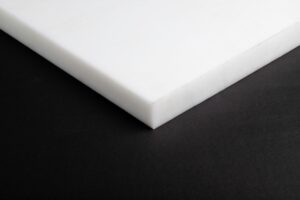Intro
A lot of people strictly use metal or 3D-printed plastic for their prototypes, but they’re completely overlooking a very strong contender: Delrin. Delrin is one of the best plastics to make machined prototypes out of, and we’re going to tell you why.
This beginner guide is all about using Delrin for prototyping. We’ll explain what it is, how to specify the type of Delrin you get, and why it’s such a great prototyping material.
What Is Delrin?
For starters, Delrin is a type of engineered plastic. “Acetal plastic” is a more general name for it, Delrin is the brand name, and the technical name is either POM or POM-C. POM stands for polyoxymethylene, but no one calls it that.
Delrin comes in a number of colors, but the most common options are either black or white. You can tell it apart from other plastics because it’s naturally shiny and feels a little slick when you touch it.
Another benefit is that Delrin is a thermoplastic, which means it can change shape under serious heat and maintain that shape after cooling.
Benefits of Delrin in Prototyping Applications
Why is this engineered plastic so good at prototyping? Let’s review some of our favorite benefits of Delrin within prototyping applications.
It’s Strong
Before getting too far, we need to point out how strong Delrin is. Standard Delrin has a yield strength of 8,000 psi while a comparable plastic like polypropylene (PP) has a yield strength of 4,800.

In simpler terms, Delrin can handle more weight and handle a heavier load before failing. For a plastic, this is pretty impressive. Of course, metals can handle more weight, but they lack a lot of important features that a plastic like Delrin offers.
This also means that you can do strength testing on your part during the prototyping phase. This will tell you exactly how viable your design is, and it will highlight shortcomings in your prototype.
Delrin Is Impact Resistant
Another area where Delrin shines is in its ability to absorb an impact without failing. Other polymers cannot do this. Delrin can even go through post-processing steps to make its impact resistance even more impressive.
You’ll see Delrin used a lot in sliding applications or as the base for jigs. In a jig, you can drop a metal part on Delrin as you position it, and Delrin won’t crack or fail.
You Can Easily Machine it
Delrin is relatively forgiving in a machine shop, unlike most plastics that you might experience. For instance, trying to drill a hole in acrylic is a nightmare — acrylic plastic can crack easily, corners can blow out, and it’s tough to get a clean cut.
With Delrin, it’s a different story. You can machine it like it’s a slab of aluminum (but with different machine speeds) and the plastic will hold up. We can achieve very clean cuts and smooth holes in Delrin.
The problem is that it takes a lot of experience before you can do this. It’s common for rookie machinists to burn Delrin and melt internal features. This is a matter of getting the speed of the machine dialed in and having enough practice.
For prototyping, being able to use a CNC machine will save you time and money. You’ll get your parts faster and won’t have to overpay for a prototype.
Enjoy a Naturally Lubricated Plastic
In applications where you need to slide or roll things on top of a surface, Delrin is an excellent choice. It’s a naturally-lubricious plastic, which means that you can slide things with ease. A lot of companies use Delrin for this point alone — other rigid plastics tend to have rough surfaces and can have high friction values which exclude them from applications that Delrin shines in.
In fact, Delrin is used in bearings and bushings for this reason alone.
Machinists Can Hold Tight Tolerances
When we machine Delrin, we can get some very tight tolerances. Again, it takes experience before we can reliably hit tight tolerances, but Delrin’s dimensional accuracy can rival aluminum and steel with ease.
If you need your prototype to fit into an assembly or get installed into your production line, this is a huge selling point. Loose tolerances mean that the overall dimension can vary a lot from your dimensioned part, which can lead to parts not fitting.
It’s a Stiffer Plastic
If you used a polycarbonate, polypropylene, or even acrylic before, you know how flimsy and floppy plastics can be. This is especially true for thinner plastics, they’re simply not stiff.
That makes it hard to call for upright pieces of plastic or long stretches of material. It will sag and be unusable.
However, Delrin doesn’t have the same problem. You can make upright, long, or thin prototypes without dealing with the same issues. Of course, Delrin will still flop when it’s especially long or thin, but it goes a lot further than any other plastic.
This makes Delrin a great option for many prototype configurations and setups. You can ditch the extra bracketry and design creativity that you would otherwise need.
You Can Thread Delrin
You might not know this, but you can thread directly into Delrin. We don’t suggest this for parts you’ll remove a lot, but it’s a perfect option for low-use threaded connections. Without the ability to thread directly into Delrin, you would need to use nuts or threaded inserts. This can dramatically complicate your part.
Delrin is easy to drill and tap, and it can hold an impressive amount of force without stripping or galling the threads.
Has a Great Appearance
Some people need a prototype so they can get buy-in from stakeholders or investors. This typically means painting and polishing a part to make it pretty. With Delrin, it’s highly presentable without any post-processing.
As a raw material, Delrin is fully colored all the way through. If we cut open a red piece of Delrin from our supplier, it will be red everywhere. You don’t even have to paint the final part for it to pop.
Since the surface is lubricious and slick, it has a nice shine to it by default.
You Can Later Injection Mold with Delrin
When you’re ready for full-scale production, you can use the exact same material that you prototyped with if you use Delrin. That’s right, Delrin can be injection molded.
It’s always best to have a prototype that uses the same material that the final product will use. In this case, you’re achieving exactly that. All of your testing during prototyping will be more useful and predictive of your final part.
Conclusion
As you just learned, Delrin is a great option for prototyping your parts. If you want to get started today, you can trust our team at Rapid Axis. We make countless Delrin prototypes for companies around the world each year. Book your next project with our expert machinists. Get a free quote today.

